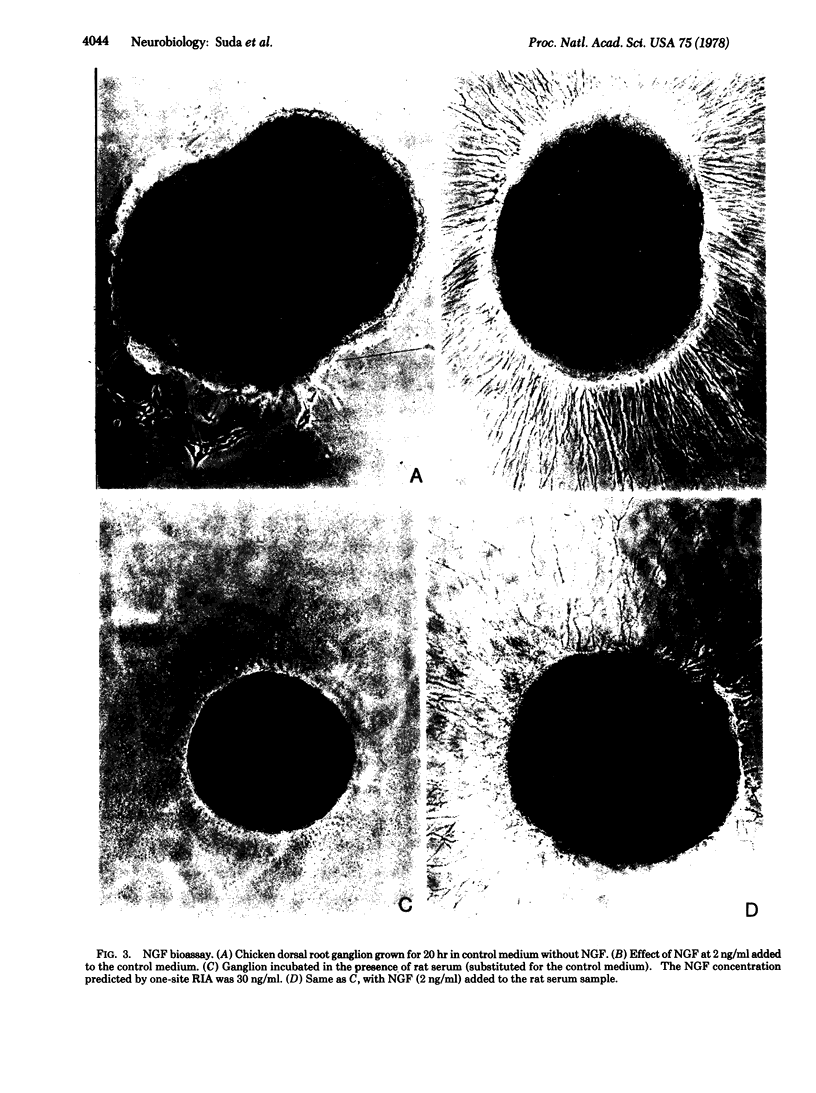Abstract
High levels of nerve growth factor (NGF) determined by competition radioimmunoassay do not agree with values obtained by bioassay. This discrepancy is illustrated here with rat and mouse serum as examples in which values up to 1000 ng/ml have been found by using competition radioimmunoassays. An explanation for the discordant results is presented: serum components bind NGF with an intermediate affinity (Kd = 10(-7) M) but with a very large capacity (up to 0.5 mg of NGF per ml of rat serum). The binding of 125I-labeled NGF to serum components competes with the binding to the solid-phase antibodies (Kd = 10(-9)M) present in limiting amounts, according to the principle of competition radioimmunoassays. Thus, less radioactivity is recovered bound to the antibodies and this gives the erroneous impression that NGF is present. To overcome this difficulty, a two-site radioimmunoassay has been developed which utilizes nonlimiting numbers of antibody binding sites. This assay provides a reliable determination of NGF levels in serum and it can be shown that in rat and mouse serum (either sex) there is less than 5 ng of NGF per ml, in agreement with the results of the bioassay.
Full text
PDF




Images in this article
Selected References
These references are in PubMed. This may not be the complete list of references from this article.
- Angeletti R. H., Hermodson M. A., Bradshaw R. A. Amino acid sequences of mouse 2.5S nerve growth factor. II. Isolation and characterization of the thermolytic and peptic peptides and the complete covalent structure. Biochemistry. 1973 Jan 2;12(1):100–115. doi: 10.1021/bi00725a018. [DOI] [PubMed] [Google Scholar]
- Angeletti R. H., Mercanti D., Bradshaw R. A. Amino acid sequences of mouse 2.5S nerve growth factor. I. Isolation and characterization of the soluble tryptic and chymotryptic peptides. Biochemistry. 1973 Jan 2;12(1):90–100. doi: 10.1021/bi00725a017. [DOI] [PubMed] [Google Scholar]
- Angeletti R. H. Nerve growth factor (NGF) from snake venom and mouse submaxillary gland: interaction with serum proteins. Brain Res. 1969 Jan;12(1):234–237. doi: 10.1016/0006-8993(69)90070-5. [DOI] [PubMed] [Google Scholar]
- Bocchini V., Angeletti P. U. The nerve growth factor: purification as a 30,000-molecular-weight protein. Proc Natl Acad Sci U S A. 1969 Oct;64(2):787–794. doi: 10.1073/pnas.64.2.787. [DOI] [PMC free article] [PubMed] [Google Scholar]
- Carstairs J. R., Edwards D. C., Pearce F. L., Vernon C. A., Walter S. J. Immunogenic contaminants in mouse nerve-growth factor. Eur J Biochem. 1977 Jul 15;77(2):311–317. doi: 10.1111/j.1432-1033.1977.tb11669.x. [DOI] [PubMed] [Google Scholar]
- Catt K., Tregear G. W. Solid-phase radioimmunoassay in antibody-coated tubes. Science. 1967 Dec 22;158(3808):1570–1572. doi: 10.1126/science.158.3808.1570. [DOI] [PubMed] [Google Scholar]
- Fenton E. L. Tissue culture assay of nerve growth factor and of the specific antiserum. Exp Cell Res. 1970 Mar;59(3):383–392. doi: 10.1016/0014-4827(70)90645-2. [DOI] [PubMed] [Google Scholar]
- GREENWOOD F. C., HUNTER W. M., GLOVER J. S. THE PREPARATION OF I-131-LABELLED HUMAN GROWTH HORMONE OF HIGH SPECIFIC RADIOACTIVITY. Biochem J. 1963 Oct;89:114–123. doi: 10.1042/bj0890114. [DOI] [PMC free article] [PubMed] [Google Scholar]
- Hendry I. A. Developmental changes in tissue and plasma concentrations of the biologically active species of nerve growth factor in the mouse, by using a two-site radioimmunoassay. Biochem J. 1972 Aug;128(5):1265–1272. doi: 10.1042/bj1281265. [DOI] [PMC free article] [PubMed] [Google Scholar]
- Johnson D. G., Gorden P., Kopin I. J. A sensitive radioimmunoassay for 7S nerve growth factor antigens in serum and tissues. J Neurochem. 1971 Dec;18(12):2355–2362. doi: 10.1111/j.1471-4159.1971.tb00190.x. [DOI] [PubMed] [Google Scholar]
- LEVI-MONTALCINI R., MEYER H., HAMBURGER V. In vitro experiments on the effects of mouse sarcomas 180 and 37 on the spinal and sympathetic ganglia of the chick embryo. Cancer Res. 1954 Jan;14(1):49–57. [PubMed] [Google Scholar]
- Levi-Montalcini R., Angeletti P. U. Nerve growth factor. Physiol Rev. 1968 Jul;48(3):534–569. doi: 10.1152/physrev.1968.48.3.534. [DOI] [PubMed] [Google Scholar]
- Levi-Montalcini R., Angeletti P. U. Second symposium on catecholamines. Modification of sympathetic function. Immunosympathectomy. Pharmacol Rev. 1966 Mar;18(1):619–628. [PubMed] [Google Scholar]
- Murphy R. A., Saide J. D., Blanchard M. H., Young M. Nerve growth factor in mouse serum and saliva: role of the submandibular gland. Proc Natl Acad Sci U S A. 1977 Jun;74(6):2330–2333. doi: 10.1073/pnas.74.6.2330. [DOI] [PMC free article] [PubMed] [Google Scholar]
- Stoeckel K., Gagnon C., Guroff G., Thoenen H. Purification of nerve growth factor antibodies by affinity chromatography. J Neurochem. 1976 Jun;26(6):1207–1211. doi: 10.1111/j.1471-4159.1976.tb07008.x. [DOI] [PubMed] [Google Scholar]
- Stöckel K., Paravicini U., Thoenen H. Specificity of the retrograde axonal transport of nerve growth factor. Brain Res. 1974 Aug 23;76(3):413–421. doi: 10.1016/0006-8993(74)90818-x. [DOI] [PubMed] [Google Scholar]
- Varon S., Nomura J., Shooter E. M. The isolation of the mouse nerve growth factor protein in a high molecular weight form. Biochemistry. 1967 Jul;6(7):2202–2209. doi: 10.1021/bi00859a043. [DOI] [PubMed] [Google Scholar]



